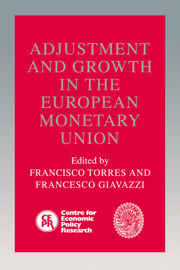Book contents
- Frontmatter
- Contents
- List of figures
- List of tables
- Preface
- List of contributors
- Foreword
- 1 Introduction
- 2 Economic and monetary union: critical notes on the Maastricht Treaty revisions
- Discussion
- 3 The design of optimal fiscal rules for Europe after 1992
- Discussion
- 4 Contracts, credibility and common knowledge: their influence on inflation convergence
- Discussion
- 5 Inflation in fixed exchange regimes: the recent Portuguese experience
- Discussion
- 6 Models of economic integration and localized growth
- Discussion
- 7 Shocking aspects of European monetary integration
- Discussion
- 8 Lessons of Massachusetts for EMU
- Discussion
- 9 Financial and currency integration in the European monetary system: the statistical record
- Discussion
- 10 Currency substitution: from the policy questions to the theory and back
- Discussion
- 11 Coordination of capital income taxes in the economic and monetary union: what needs to be done?
- Discussion
- Index
Discussion
Published online by Cambridge University Press: 29 January 2010
- Frontmatter
- Contents
- List of figures
- List of tables
- Preface
- List of contributors
- Foreword
- 1 Introduction
- 2 Economic and monetary union: critical notes on the Maastricht Treaty revisions
- Discussion
- 3 The design of optimal fiscal rules for Europe after 1992
- Discussion
- 4 Contracts, credibility and common knowledge: their influence on inflation convergence
- Discussion
- 5 Inflation in fixed exchange regimes: the recent Portuguese experience
- Discussion
- 6 Models of economic integration and localized growth
- Discussion
- 7 Shocking aspects of European monetary integration
- Discussion
- 8 Lessons of Massachusetts for EMU
- Discussion
- 9 Financial and currency integration in the European monetary system: the statistical record
- Discussion
- 10 Currency substitution: from the policy questions to the theory and back
- Discussion
- 11 Coordination of capital income taxes in the economic and monetary union: what needs to be done?
- Discussion
- Index
Summary
To travel hopefully is often better than to arrive. In Stage II we are travelling hopefully; this chapter is about what may happen if we arrive. Some of us hope that we will not make it - the authors seem to agree with those concerns. My fellow discussant, Giorgio Basevi, has added his concerns from one of the countries which in this chapter is classified as on the ‘periphery’; I might add that if a peripheral country in the authors' optimal currency area sense, such as Italy or Britain, were to be forced into the ‘core’, then these countries would risk becoming peripheral in the more usual sense of being retarded in growth.
There are two main arguments advanced for EMU. The first promotes the gain in monetary policy credibility and so in price stability that could come from a single independent European central bank, able to avoid and prevent the time-inconsistency of national policy-making. The second states that the gains from reduced transactions costs and exchange rate uncertainty outweigh the losses from the lack of national exchange rate (and interest rate) adjustment to differential (or ‘asymmetric’) regional shocks.
This last argument centres around the ‘optimal currency area’ debate and is the focus of this chapter. This investigates the extent to which the EC regions (countries) have differential shocks and adjust more slowly than US regions, which are taken to be the benchmark for a successful monetary union.
- Type
- Chapter
- Information
- Adjustment and Growth in the European Monetary Union , pp. 235 - 240Publisher: Cambridge University PressPrint publication year: 1993
- 1
- Cited by



